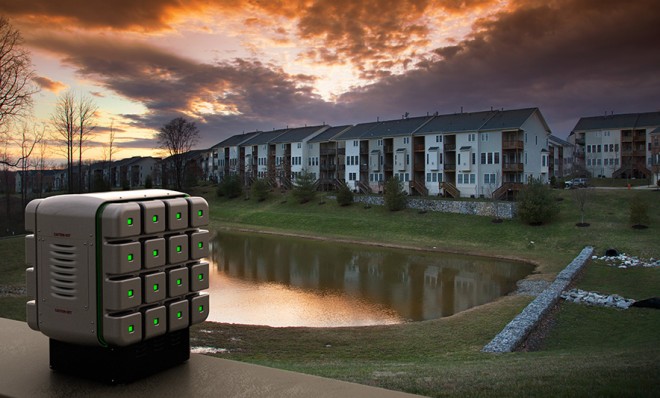Meet The Cube: The fuel cell of the future?
It promises all the benefits of a regular fuel cell at one-tenth the size and cost

Redox Power Systems, a Maryland-based start-up founded last year, has teamed with researchers at the University of Maryland Energy Research Center to develop a new kind of fuel cell that tackles some of the technology's toughest challenges.
Their product, The Cube, is a little larger than a dishwasher, has no engine or moving parts, and can silently produce a constant supply of energy, optionally off the power grid. It's also one-tenth the size and one-tenth the cost of commercial fuel cells on the market. Oh, and it happens to glow neon green.
For the uninitiated, a fuel cell looks a bit like a giant battery, but rather than storing electricity, it creates it via a chemical reaction between a fuel source and oxygen. (The first generation Cube runs on natural gas.) As long as it has a steady stream of fuel and oxygen, the reaction keeps going.
The Week
Escape your echo chamber. Get the facts behind the news, plus analysis from multiple perspectives.

Sign up for The Week's Free Newsletters
From our morning news briefing to a weekly Good News Newsletter, get the best of The Week delivered directly to your inbox.
From our morning news briefing to a weekly Good News Newsletter, get the best of The Week delivered directly to your inbox.
NASA's space program used the first commercial fuel cells to generate power for probes, satellites, and space capsules. Now, they're commonly used for back-up power in case of emergencies.
The potential benefits of this kind of technology are enormous. They provide a source of electricity that's nearly immune to weather disasters and cyber-attacks, while at the same time creating almost no polluting substances and way less CO2 than other energy sources.
But two main challenges have limited their use. One, they typically operate at very high temperatures — around 950 degrees Celsius. And two, they're quite expensive.
That's where The Cube comes in. Phsy explains:
A free daily email with the biggest news stories of the day – and the best features from TheWeek.com
[Professor Eric Wachsman, who lead the development process,] decreased the operating temperature of solid oxide fuel cells to 650 degrees Celsius, with future reductions likely to 300 degrees. At these lower temperatures, the system can turn on much more rapidly, operate with greater reliability, and Redox can build out The Cube with conventional stainless steel parts rather than expensive alloys.
But Wachsman didn't stop there. Drawing upon scores of graduate and undergraduate students over two and a half decades, millions of dollars in research funding and a state-of-the-art laboratory at the University of Maryland, he created fuel cells that generate ten times the power at these lower temperatures than anything else on the market, cutting the system's cost by a factor of ten. [Phsy]
Another bonus: The energy efficiency of fuel cells is generally 40 to 60 percent. The Cube boasts an 80 percent efficiency rate.
So why don't we all all just leap off the grid and buy a Cube?
The biggest reason is that they're still very expensive. The Cube's price isn't yet available, but a regular system can cost $50,000 and another $4,000 to install. Even if The Cube is a fraction of the cost, that's still far too expensive for the average home.
Manufacturers say they can cut your utility bills by up to 40 percent a year, which amounts to saving $890 for the average customer. Still tough to justify.
Also, The Cube will be set to 25 kilowatts, the right charge to power a gas station, moderately sized grocery store, or small shopping plaza. It won't tackle a 5 kilowatt version, the proper size for the average American home, until sometime in the future.
Carmel Lobello is the business editor at TheWeek.com. Previously, she was an editor at DeathandTaxesMag.com.
-
 Film reviews: ‘Hamnet,’ ‘Wake Up Dead Man’ and ‘Eternity’
Film reviews: ‘Hamnet,’ ‘Wake Up Dead Man’ and ‘Eternity’Feature Grief inspires Shakespeare’s greatest play, a flamboyant sleuth heads to church and a long-married couple faces a postmortem quandary
-
 Poems can force AI to reveal how to make nuclear weapons
Poems can force AI to reveal how to make nuclear weaponsUnder The Radar ‘Adversarial poems’ are convincing AI models to go beyond safety limits
-
 The military: When is an order illegal?
The military: When is an order illegal?Feature Trump is making the military’s ‘most senior leaders complicit in his unlawful acts’